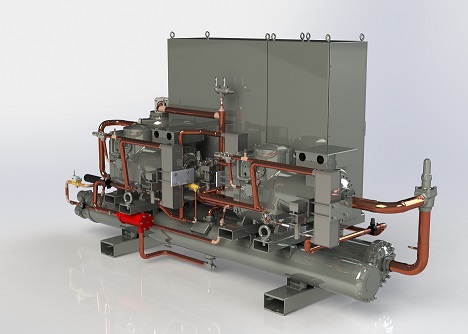Clean Heating
Groundwater Heat Pumps
A Groundwater Heat Pump works by recovering heat stored naturally in groundwater or aquifers. The water passes through heat pumps to yield its low grade heat before being returned to the aquifer at a lower temperature.
Groundwater heat pumps benefit from the thermal inertia of water in aquifers
A heat pump can concentrate heat by compressing refrigerant gases into a small volume and then transferring the heat into buildings to provide warmth via heat exchangers. The refrigerant gas becomes cold when the pressure is released and this coldness can be exchanged with warmer water from the aquifer – and the cycle can be repeated continuously. The effect is to transfer heat from the aquifer into the building.
Some interesting points to note:
- groundwater heat pumps will become more common as the UK electricity grid decarbonises
- the use of heat pumps is growing as the government subsidises low-carbon heat sources with the Renewable Heat Incentive
- air source heat pumps, which heat exchange with ambient air, are cheaper to install than ground source heat pumps, but they are at their least efficient on the coldest days when they are most needed.
- An aquifer is warmer than the air in winter, so a groundwater heat pump is more efficient than an air source heat pump – because of the thermal inertia of the water from the previous summer.
- The ground is also warmer than the air, so a ground source heat pump is also more efficient than an air source heat pump – because of the thermal inertia of the ground from the previous summer.
Advantages of Groundwater Heat Pumps
Water has a high capacity to hold heat in relation to its volume; it readily absorbs heat and readily delivers it: it enjoys a high transfer rate. It is more efficient for a heat pump to exchange heat with water than air – which enables a groundwater heat pump to outperform an air source heat pump. A groundwater heat pump also uses water to transfer heat from the ground to its building.
The thermal capacity and thermal inertia of water enables it to retain some of the solar heat gained in the summer through to the winter. Groundwater in aquifers is warmer than the air temperature on cold winter days and thus provides a more attractive input temperature to a heat pump.
A well engineered groundwater heat pump system has access to a large volume of water: this enables it to extract heat from a very large heat source whose temperature will not change significantly as relatively small amounts of heat are extracted from it.
Disadvantages of Groundwater Heat Pumps
The disadvantages of an open loop heat pump system include the need to meet the additional engineering challenges of dealing with water which may contain debris or unstable pH values and may call for additional pumping loads. It will also be necessary to meet the abstraction requirements of the Environmental Agency on all but the smallest of schemes.
The key disadvantage of using a very large body of water to achieve heat exchange with a relatively constant temperature is that you are not able to store summer heat in that body of water – to have the benefit of retrieving those higher temperatures in winter.
High Temperature Groundwater Heat Pumps
The CoP of a heat pump will generally improve the lower the output temperature it is designed to deliver: therefore the designer aims for a well designed heat emitter system such as underfloor heating where 40°C is sufficient to provide comfortable temperatures. However, if a heat pump is to be used in an existing building with limited heat emitters for the heat load, such as undersized radiators, then it may be appropriate to specify a high temperature heat pump to avoid the disruption that would be caused by refurbishing the heat emitter system.
There are now heat pumps capable of delivering output temperatures of 80°C which is more than sufficient for DHW needs and to warm a building with undersized radiators. Although the CoP will fall if output temperatures are raised to 80°C, a well designed inverter-driven high temperature heat pump with a good control system, including weather compensation, will only deliver 80°C when it is required: otherwise it will modulate the heat pump to deliver lower temperatures – at a higher efficiency – when the heating load is below peak requirements.
Heat pumps can play an important role in balancing supply and demand
It has been said that: "Heat pumps could also play an important role in balancing supply and demand in future energy systems. Electricity is difficult to store, but heat can be stored easily in the form of hot water."
In fact, heat pumps will be able to play a far more significant part when it is understood that heat pumps can do much more than store a small amount of heat overnight in small hot water tanks: heat pumps can play a significant part in interseasonal heat transfer systems when the ground itself can be used as a very large store of solar heat energy from summer to winter.
Electrification of Heat
There are now new ways of organising information and temperature to provide renewable heating and renewable cooling by recycling heat in district circuits.
The search for new techniques to control carbon emissions is advancing. There are alternatives to burning fossil fuels to keep us warm in winter – and cool in summer. The answer is to recycle heat between seasons and within districts – and by recycling heat it is also possible to provide heating without contributing to air pollution.
Demand Response and Distributed Heat Storage
The demand for electricity fluctuates during each 24 hour day. The supply of electricity also fluctuates, with photovoltaic cells generating electricity on clear days and wind turbines when the wind is blowing.
The National Grid must be able to guarantee power at times of peak demand.
"Demand Response" can be used to stimulate use of electricity at off-peak times (by lowering prices) and to discourage use of electricity at peak times (by increasing prices). Demand response goes hand-in-hand with temporary heat storage in insulated hot water cylinders: a low price signal can be used to trigger heat pumps to increase the temperature of DHW storage.
District Heating Networks
The BEN Consortium has been involved in the design and installation of the following district heating schemes based on heat pumps:
- Balanced Energy Network: an open loop aquifer system at London South Bank University
- Owen Square District Heating: a closed loop system at Easton, Bristol, including summer recharge.



